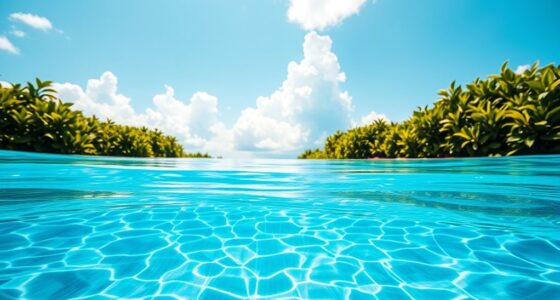Choosing between an endless pool and a lap pool depends on your space, budget, and exercise goals. Endless pools are compact, versatile, and great for small spaces, offering convenience with adjustable currents and low maintenance. Lap pools provide longer distances for traditional swimming and endurance, but require more room and higher costs. Each fits different lifestyles—discover which one aligns best with yours and why the right choice can enhance your fitness journey.
Key Takeaways
- Endless pools are space-saving, versatile, and easier to maintain, ideal for small indoor or outdoor areas.
- Lap pools offer longer swimming distances for endurance training but require more space and higher upfront costs.
- Endless pools excel in low-impact, water resistance exercises with adjustable currents, while lap pools focus on traditional swimming.
- Cost-wise, endless pools tend to be less expensive initially but may have higher energy costs; lap pools generally demand more investment.
- The best choice depends on your space, exercise goals, budget, and aesthetic preferences, with each serving different user needs.
Overview of Endless Pools and Lap Pools
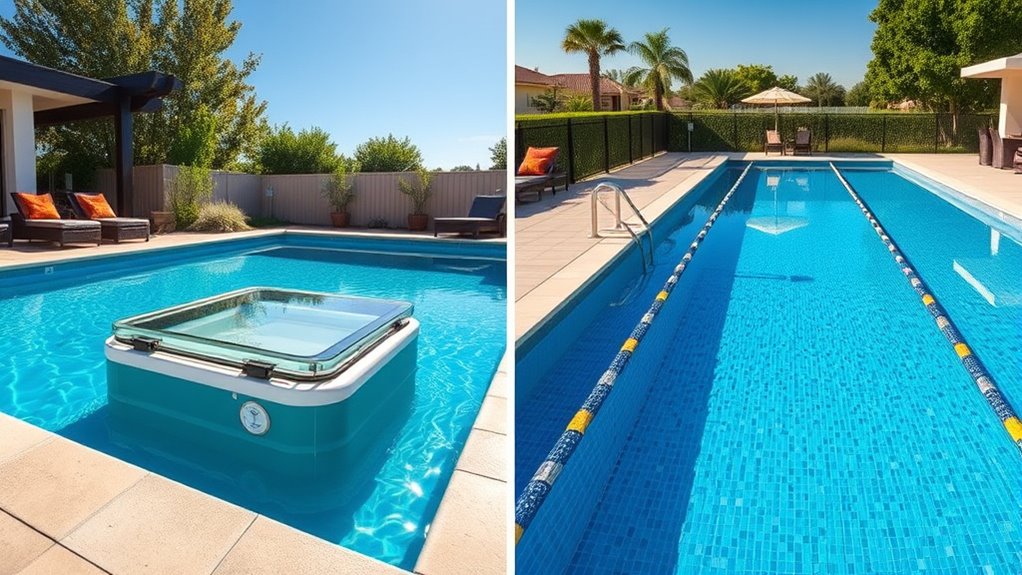
Are you curious about the main differences between endless pools and lap pools? Endless pools are compact, integrated systems designed for versatile use in small spaces. They typically feature a built-in, adjustable current that allows you to swim in place, making them ideal for indoor use or limited outdoor areas. Unbiased advice can help you determine which pool type best suits your needs and budget. Lap pools, on the other hand, are longer, traditional pools meant for continuous swimming. They come in various sizes and are often installed outdoors but can be built indoors as well. While lap pools emphasize distance and continuous strokes, endless pools focus on convenience and versatility. Both options serve swimming enthusiasts but cater to different needs based on space, usage, and personal preferences. Understanding these basics helps you decide which fits your lifestyle better.
Space Requirements and Installation Considerations
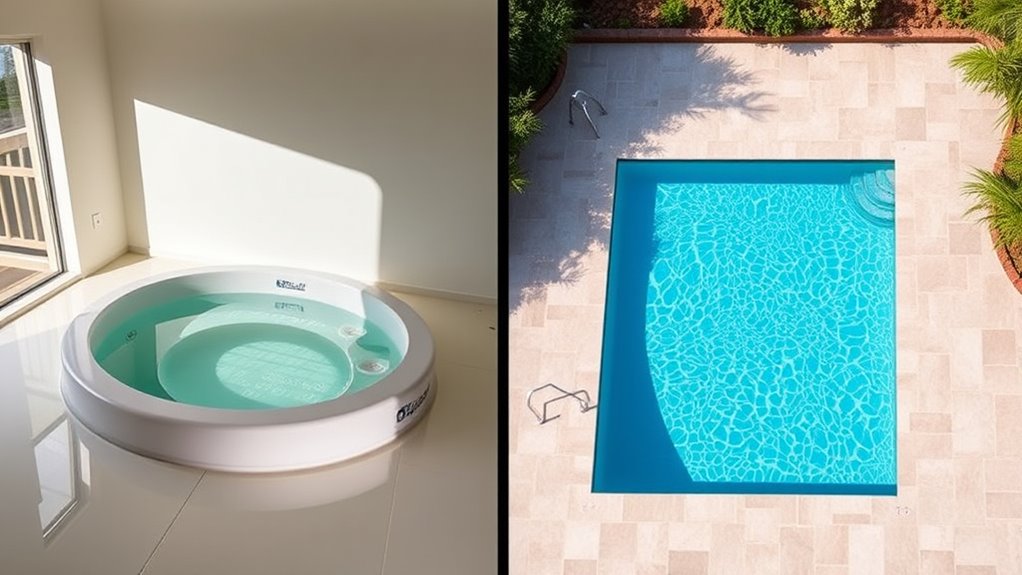
When choosing between an endless pool and a lap pool, considering available space and installation needs is essential. Endless pools are compact, fitting into smaller areas like basements or garages, while lap pools require more room for length and width. You’ll need a solid, level surface and sufficient clearance for safe use and maintenance. Additionally, selecting the right installation setup can impact long-term enjoyment and usability.
Cost Analysis and Budget Implications
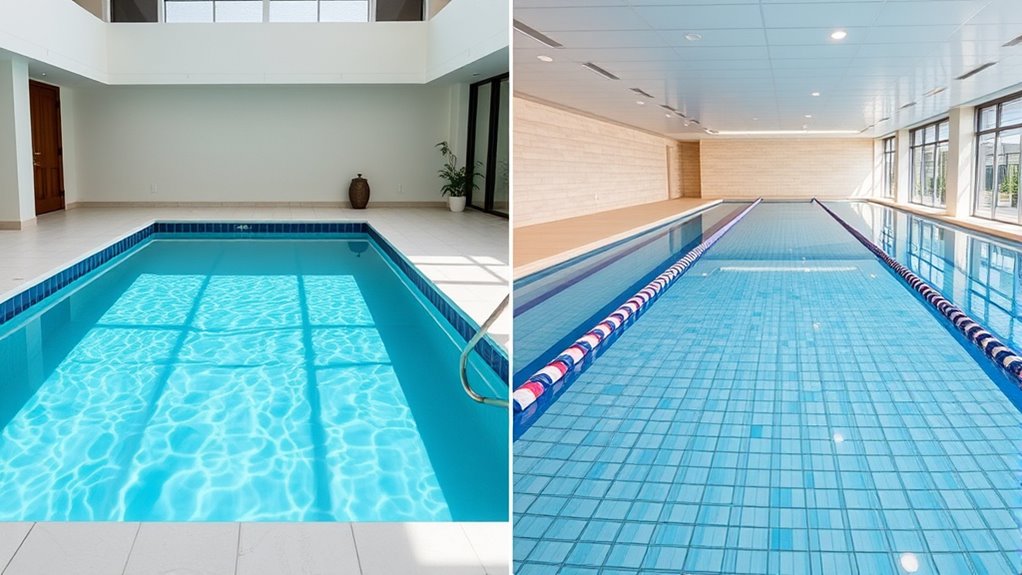
When comparing endless pools and lap pools, you’ll notice significant differences in purchase prices, with endless pools often costing less upfront. However, you should also consider ongoing maintenance and operating costs, which can affect your long-term budget. Additionally, safety considerations such as proper installation and equipment maintenance are crucial for both types of pools. Ultimately, evaluating the long-term investment value helps determine which option aligns best with your financial goals.
Purchase Price Differences
Although both endless pools and lap pools vary in price, the initial purchase cost is a key factor to contemplate when budgeting for your backyard setup, as it can considerably influence your overall investment. Endless pools typically start at a lower price point, making them more accessible for many homeowners. In contrast, lap pools often require a larger footprint and more materials, increasing the upfront expense. Your choice depends on your budget and space availability. Consider these factors:
- Endless pools usually cost between $10,000 and $20,000, including installation.
- Lap pools can range from $15,000 to over $50,000, depending on size and features.
- Additional costs like site preparation, permits, and accessories can further impact total expenses.
- Design flexibility is also an important consideration, as endless pools can often be integrated into smaller outdoor spaces more easily than traditional lap pools.
A clear understanding of these price differences helps you make an informed decision aligned with your financial plan.
Maintenance and Operating Costs
While the initial purchase price is an important consideration, understanding the ongoing maintenance and operating costs is equally essential for budgeting effectively. Endless pools typically have higher electricity costs due to their larger size and continuous filtration systems, which can add up over time. They also require regular cleaning, chemical balancing, and occasional repairs, increasing your expenses. Additionally, the refresh rate of an endless pool’s filtration system can influence overall energy consumption. In contrast, lap pools often have lower energy consumption since they’re usually larger and built for straightforward swimming, but they may need more frequent cleaning and maintenance of the structural components. Overall, endless pools might demand higher monthly costs for electricity and upkeep, while lap pools could have lower operating expenses but potentially higher maintenance due to their size. Consider these ongoing costs when choosing the best fit for your budget.
Long-term Investment Value
Investing in an endless pool often requires a higher upfront cost, but its long-term value depends on ongoing expenses and durability. While the initial investment is steeper, you may save money over time due to lower maintenance and energy costs. Endless pools are typically more durable, with parts designed for longevity, reducing replacement frequency and expenses. Conversely, lap pools often have lower initial prices but can incur higher costs through upkeep and repairs. To evaluate which offers better value, consider:
- Energy efficiency and utility bills over the lifespan
- Durability of materials and expected lifespan
- Maintenance frequency and associated costs
- Personal growth strategies can also influence your ability to manage long-term investments effectively.
Features and Functionality Comparison
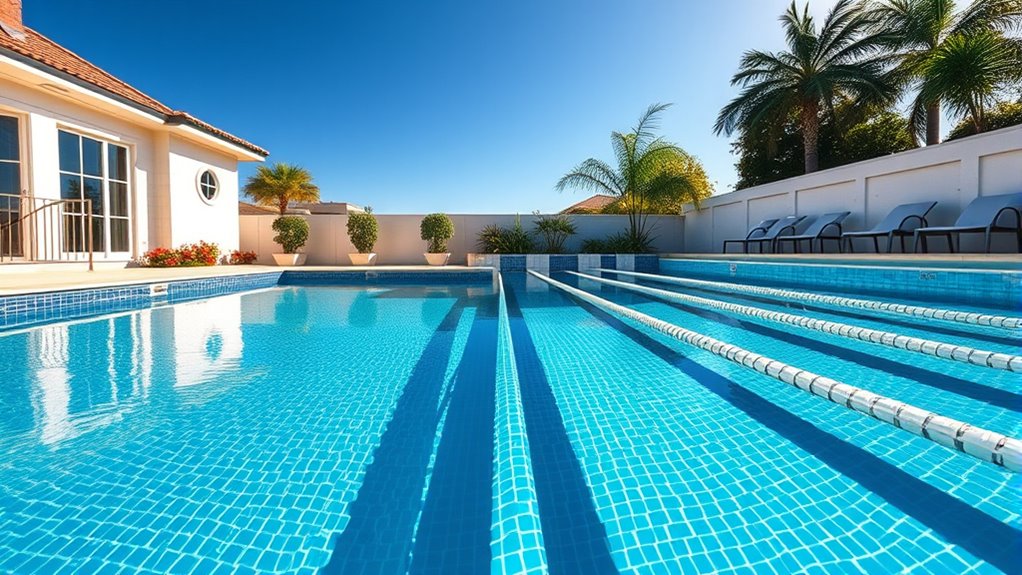
When comparing the features and functionality of endless pools and lap pools, it’s important to contemplate how each design caters to different swimming needs. Endless pools are compact and often come with adjustable current systems, allowing you to swim in place and customize resistance levels. They typically feature built-in jets or counter-current systems that enable continuous swimming without needing a large space. While lap pools provide more space for various strokes and exercises, endless pools focus on convenience and versatility in small areas. Your choice depends on whether you prioritize space-saving features or a more traditional swimming environment. Additionally, Health – Greek Sceptic emphasizes the importance of proper hydration and recognizing fatigue signs, which can be relevant for swimmers aiming to prevent running dry during workouts.
Ideal Users and Usage Scenarios
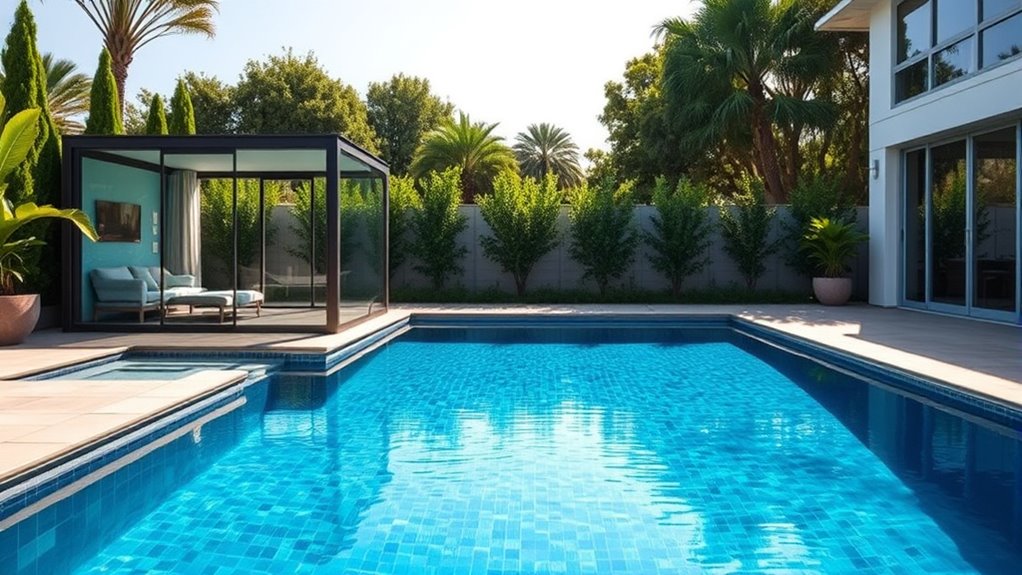
Your space and mobility needs will influence whether an Endless Pool or lap pool suits you best. If you want versatile use in a small area, the Endless Pool may be ideal, while larger spaces accommodate traditional lap pools. Consider your training and exercise goals to determine which setup helps you stay motivated and effective. Additionally, understanding installation requirements and safety considerations can ensure your chosen pool remains safe and functional over time.
Space and Mobility Needs
Choosing between an endless pool and a lap pool depends heavily on your space constraints and mobility needs. If your area is limited, an endless pool offers a compact, all-in-one solution that fits into smaller spaces. Conversely, if you have ample room, a traditional lap pool provides more flexibility for multiple users and varied movement. Consider your mobility requirements: an endless pool is ideal if you prefer seated or low-impact activities and need easier access. A lap pool suits those who want to swim longer distances comfortably. Additionally, your ability to communicate and coordinate during workouts can influence which pool type best supports dynamic communication exercises and social interaction.
- Limited space and need for easy access? Endless pools are a smart choice.
- Ample space and multiple users? Lap pools offer greater versatility.
- Mobility considerations? Endless pools accommodate low-impact and seated exercises.
Training and Exercise Goals
If your primary goal is focused on specific training routines or targeted exercises, selecting the right pool depends on how you plan to use it. An endless pool is perfect if you want adjustable resistance for water aerobics, strength training, or low-impact cardio. Its compact size allows you to perform interval training and technique drills comfortably. Additionally, the versatility of an endless pool makes it suitable for customized workout routines, enabling users to adapt their exercises to their evolving fitness levels. On the other hand, a lap pool is ideal if your goal is endurance and long-distance swimming. It provides a larger space for continuous laps, helping you build stamina and improve form. Consider your workout style—if you prefer focused, versatile sessions, an endless pool is a great fit. If continuous, distance-based training aligns with your goals, a lap pool offers the space you need. Your choice should match your exercise objectives and preferred routines.
Maintenance and Operating Expenses
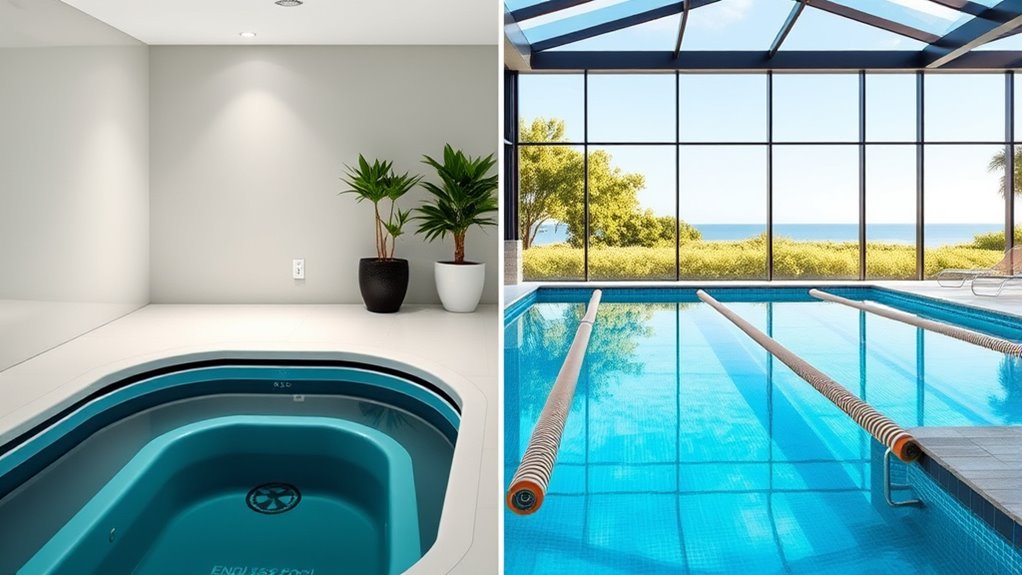
When it comes to maintenance and operating expenses, endless pools typically cost less to keep in good condition than traditional lap pools. Their compact design reduces the need for extensive cleaning and regular upkeep. You’ll find that they generally consume less energy, thanks to efficient pumps and heating systems. Plus, since they are often built with durable, corrosion-resistant materials, repairs are less frequent and less costly over time.
- Lower energy consumption due to smaller size and efficient components
- Reduced water usage and evaporation, minimizing refill costs
- Less routine cleaning and fewer parts prone to wear and tear
Design Aesthetics and Customization Options

Endless pools offer a sleek, modern look that seamlessly integrates into various backyard designs, giving you more control over aesthetics. You can choose from a range of colors, finishes, and layouts to match your outdoor space and personal style. Many models allow for customization of deck materials and lighting, creating a cohesive and inviting environment. Because these pools are compact and streamlined, they tend to blend well with contemporary landscaping or minimalist themes. Additionally, some manufacturers offer optional features like custom covers or integrated seating, enhancing both appearance and functionality. This flexibility helps you craft a personalized pool area that complements your home’s architecture while maintaining a clean, sophisticated look. Ultimately, endless pools put you in charge of how your pool fits into your overall outdoor aesthetic.
Pros and Cons of Endless Pools
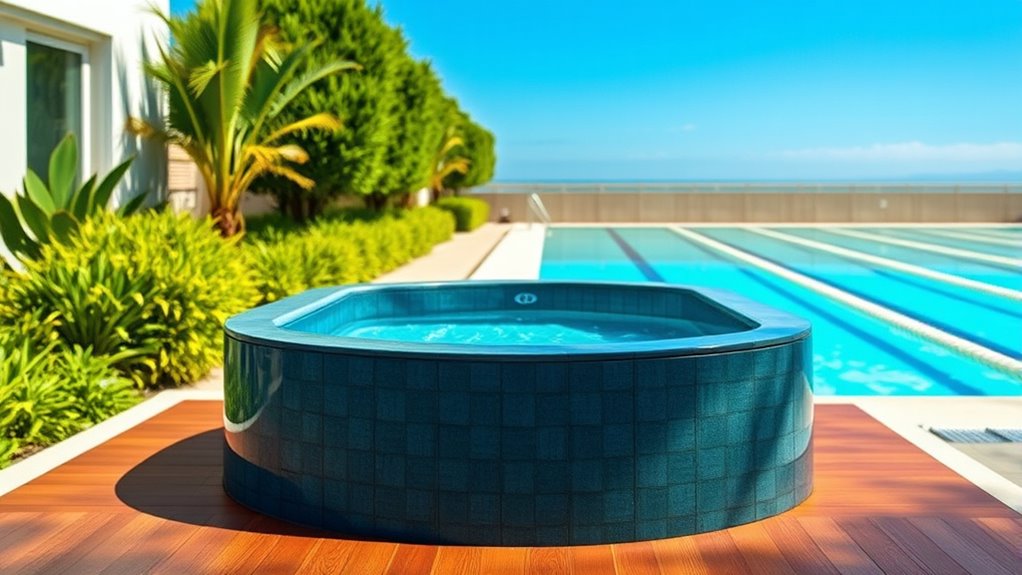
Endless pools offer space-saving benefits, making them ideal if you have limited room. They can be easier to maintain and often cost less over time compared to traditional lap pools. Plus, their fitness versatility lets you perform a variety of workouts, but you’ll want to weigh these advantages against potential drawbacks.
Space Efficiency Benefits
Because space is often a major consideration, endless pools offer significant advantages for those with limited room. Their compact design allows you to enjoy the benefits of a pool without sacrificing valuable square footage. This makes them ideal for small yards, basements, or multi-purpose areas. You can install an endless pool indoors or outdoors, maximizing versatility. Additionally, their smaller footprint means easier installation and less disruption to your property. You gain a functional swimming space without the need for extensive construction or land clearance. The efficient design also allows for easier maintenance and cleaning, saving you time and effort. Overall, endless pools provide a practical, space-saving solution that fits seamlessly into tight or multi-use spaces.
- Compact footprint suitable for limited areas
- Flexible indoor or outdoor installation
- Easier setup and maintenance
Maintenance and Costs
Maintaining an endless pool typically involves less effort and lower costs compared to traditional pools, thanks to its smaller size and integrated systems. You save on water, chemicals, and cleaning time. The compact design means fewer parts to repair, reducing maintenance expenses. However, the initial investment can be higher, and replacement parts might be pricier due to specialized components.
| Aspect | Pros | Cons |
|---|---|---|
| Cost of Setup | Lower than large pools | Higher than portable options |
| Maintenance Effort | Minimal, routine cleaning needed | Specialized parts may be costly |
| Chemical Use | Less chemicals required | Regular testing still necessary |
| Repairs | Fewer components prone to failure | Repair costs can be high |
| Operating Expenses | Lower energy consumption | Ongoing costs add up over time |
Fitness Versatility
With their compact size and integrated systems, endless pools offer a versatile platform for various fitness routines. You can easily customize workouts to target different muscle groups, mix aerobic and strength training, or practice water-based rehabilitation. Their adjustable current allows you to set different speeds, making them suitable for swimmers of all levels. Plus, the warm water environment reduces joint impact, enabling longer, more comfortable sessions.
- Multi-Functional Use: Swim, perform water aerobics, or strength exercises.
- Customizable Resistance: Adjust current to match your fitness level.
- Rehabilitation Friendly: Low-impact environment supports recovery and injury prevention.
Pros and Cons of Lap Pools
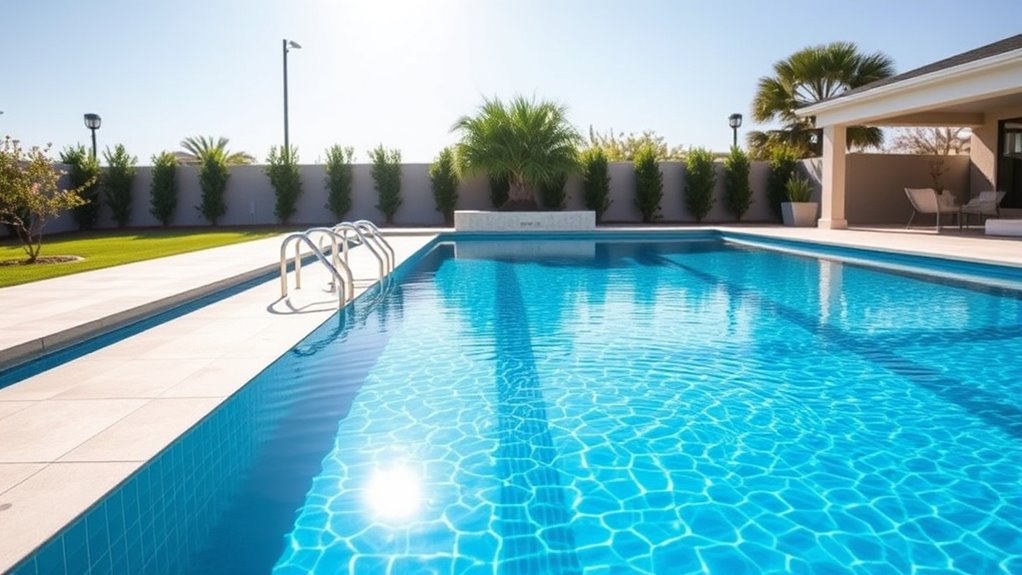
Lap pools offer a dedicated space for efficient swimming workouts, making them popular among fitness enthusiasts. Their long, narrow design allows you to focus solely on swimming without interruptions. One major advantage is that they provide ample space for sustained, uninterrupted laps, helping you build endurance and improve technique. They also tend to have minimal features, which keeps maintenance straightforward and costs lower over time. However, there are drawbacks. Their size can be a limitation if space is limited in your home or yard. They’re also less versatile for other activities like water aerobics or casual lounging. Additionally, installing a lap pool can be expensive and time-consuming. Overall, lap pools are ideal if your primary goal is focused swimming, but they might not suit those seeking multi-purpose water features.
Which Pool Type Best Suits Your Lifestyle?
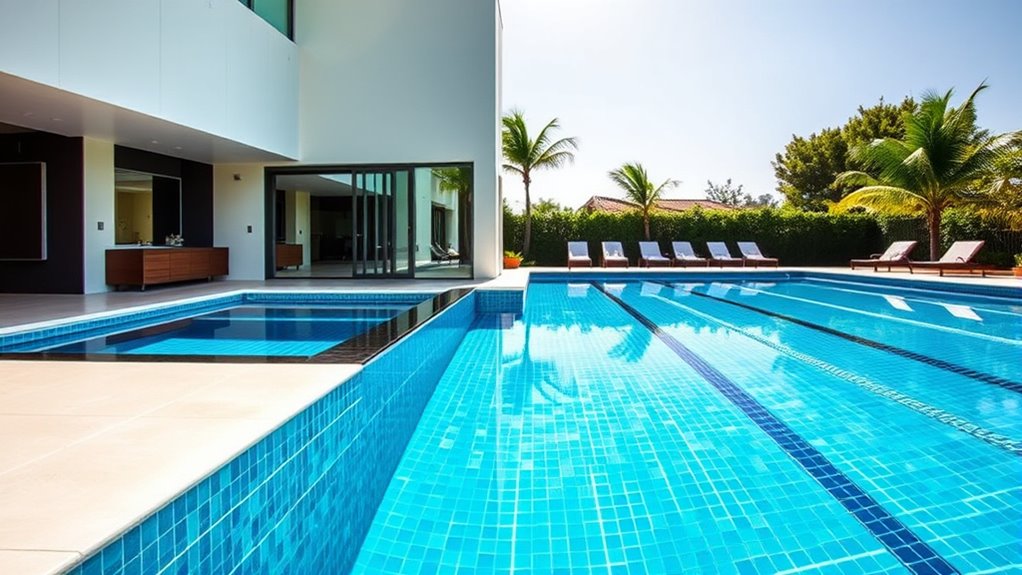
Choosing the right pool type depends heavily on your lifestyle and how you plan to use it. If you prioritize convenience and space efficiency, an endless pool offers a compact solution perfect for daily workouts or relaxing at home. On the other hand, if you enjoy long, uninterrupted swims or hosting multiple guests, a lap pool might better fit your needs. Consider your physical activity level, available space, and maintenance preferences.
- Frequency of use: daily workouts or occasional leisure
- Space constraints: limited yard or ample outdoor area
- Budget and maintenance: upfront costs versus ongoing upkeep
Frequently Asked Questions
How Long Does Installation Typically Take for Each Pool Type?
Installation usually takes about one to two weeks for an Endless Pool, since it’s compact and often pre-fabricated. For a traditional lap pool, expect three to six weeks, depending on size, site prep, and whether you’re doing in-ground or above-ground. You can speed up the process by working closely with contractors and ensuring all permits and utilities are ready beforehand.
Are There Any Safety Features Unique to Either Pool?
You’ll find that endless pools often include safety features like touch controls, automatic shut-offs, and secure covers to prevent accidental access. Lap pools, on the other hand, typically focus on sturdy fencing, non-slip surfaces, and proper lighting. Both pool types prioritize safety, but endless pools emphasize automated safety systems, while lap pools rely more on physical barriers and design. Your choice depends on which safety features best suit your needs.
Which Pool Type Has Better Energy Efficiency?
A lap pool generally offers better energy efficiency because it’s larger and has a traditional filtration system, which consumes less power per gallon. Endless pools, being smaller and often equipped with advanced, energy-saving features like adjustable jets and heaters, can also be efficient if used wisely. However, if you prioritize lower energy costs and minimal maintenance, a lap pool might be your best bet.
Can Both Pools Be Used Year-Round Indoors?
Think of your indoor pool as a warm embrace that lasts all year. Yes, both endless and lap pools can be used year-round indoors, provided you maintain proper climate control and insulation. You’ll want to guarantee your space stays warm and dry, so you can enjoy swimming no matter the season. With the right setup, your indoor pool becomes a sanctuary of comfort, inviting you to swim whenever you desire.
What Are the Warranty Options for Each Pool?
You typically get warranties that cover structural components, equipment, and motors for both pools, often ranging from 5 to 10 years. Endless Pools offer extensive coverage with options for extended warranties, while lap pools depend on the manufacturer and specific model. You should read the warranty details carefully and consider purchasing extra coverage if available to guarantee peace of mind and protection against future repairs.
Conclusion
Ultimately, choosing between an endless pool and a lap pool depends on your specific space, style, and swim goals. Weigh the worth of the whirl of features against the wallet’s weight, and consider your needs for convenience or customization. Whether you crave compact comfort or spacious splashes, making a mindful decision will match your movement and mindset. Immerse yourself in your dream pool with confidence, and enjoy endless enjoyment or lap-limited leisure!





